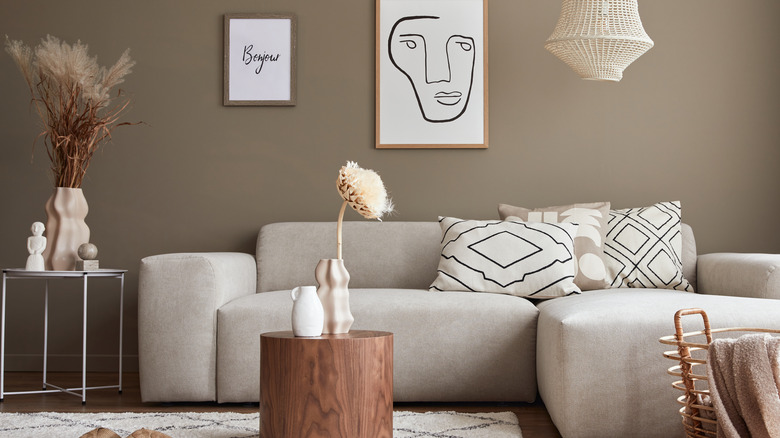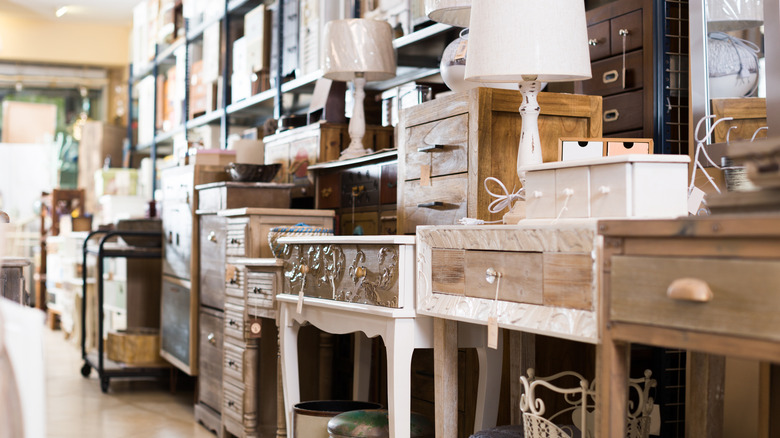How To Furnish Your New Place Without Going Broke
Moving into a new home? Whether you're moving with family, getting your own studio apartment, or taking the leap to move in with your partner, you're probably bursting with excitement over the idea of making this new space your own. Sure, some of your current belongings will migrate over in a moving truck, but there's just something so refreshing about getting new furniture and decor to personalize your next dwelling.
Here's the thing, though: moving comes with a lot of expenses. If you're renting, you have to be prepared for deposits, pet fees, and renter's insurance, to name a few. And if you're buying, not only are you on the hook for a big down payment and your new mortgage, but there are all sorts of inspections, closing fees, and other unexpected bits of bureaucracy that can chip away at your moving budget. The cost of moving your stuff alone can range from hundreds to thousands of dollars, depending on the size of your home and the distance you're traveling (via Moving.com).
Long story short? You likely won't have an endless supply of cash left over to furnish your new living arrangements. But that doesn't mean that a fresh vibe is out of your reach! You can still use your move as an opportunity to replace, refine, and reimagine elements of your personal style. If you want to stock your new home with new-to-you furniture and decor, here's how to do it without going broke.
Set a decor budget (and stick to it)
In the midst of a chaotic move, a clear budget will be your best friend. In addition to accounting for all those pesky moving costs, set a certain amount aside for furnishings. This can be a total budget that you track continuously or a monthly stipend that you give yourself to decorate a little bit at a time. It's all about evaluating your income and expenses to see what you can comfortably afford. In other words, deciding how much of your money you're willing and able to spend on furnishings.
The easiest way to do this is to take your total income, subtract your bills, and see what's left over (via U.S. News & World Report). Then you can decide how much of this discretionary income should be allocated to home goods. If you want to spend a chunk all at once, probably do this calculation using your yearly income, so you know how much spending you can absorb over time. If you want to set a monthly decorating budget, do this using monthly figures, instead. The most important thing is that you don't get overexcited and spend more than you can afford, or put yourself in debt outfitting your home.
Prioritize your furnishing purchases
One way to easily stay on budget is by prioritizing your purchases based on urgency. As a rule, it's best to get the most important items first, and save the "wants" until after the "needs." For example, you may want to pay for that new sofa before frittering away a few hundred dollars on vases and wall hangings. Or you may want to prioritize much-needed kitchen appliances over throw pillows and new cabinet pulls. This way, if you suddenly realize that you're blowing through your budget too quickly, you've at least ensured that the most necessary furnishings have been acquired.
But how can you tell which items are the most mandatory for your unique home? The trick is to start with the things you'll personally get the most use out of. As interior designer and entrepreneur Ashley Marino tells Rocket Homes, "Do you love snuggling on the couch while watching Netflix, or are you a host who loves to have dinner parties? Prioritize the areas that you'll be in most when it comes to purchasing furniture."
Reap the savings of second-hand shopping
Once you have a budget and priorities in mind, the next tactic for furnishing your home is to help that budget go as far as possible. And since buying everything new off the sales floor can add up quickly, it may be worth exploring the world of second-hand decor. Many thrift stores or charity shops carry home goods, from furniture and tchotchkes to electronics. This can mean a more cost-effective way to tick items off your to-buy list.
Find a few favorite thrift shops in your area and, if possible, befriend the staff. They can help you keep an eye out for particular pieces you're looking for, and may even put them aside or phone you when items come in (via The Krazy Koupon Lady). Also, bear in mind that different shops may have different offerings. For instance, Habitat for Humanity ReStores specialize in furniture, appliances, and home accents, so if there's one in your area, it could be a great resource after your move.
Time purchases to take advantage of sales
If you need a big-ticket item that can't be bought second-hand, the next best way to save significant money is strategically shopping at sales events. Take white sales, for example. White sales typically feature steep discounts on bed and bath items, such as towels and linens. So, if you're trying to get sheets and comforters for your new home, timing these purchases around white sales can help you save cash.
While white sales can pop up throughout the year, they are most popular in January (via HGTV). If that's awkward timing for your move, though, don't despair; you can often find good home and appliance deals around other markdown events, such as Memorial Day, Labor Day, or Black Friday sales.
If it's not urgent, sleep on it
Furnishing your new home can be fun and exciting, so it's easy to get carried away on your decor binge. To help protect yourself and your wallet from impulse purchases, commit yourself to waiting a day or two before you head to the register or click the checkout button. "Impulsive shopping is all about seeing something and creating this very spontaneous, unmindful, unreflective urge," Mousumi Bose Godbole, professor of marketing at Fairfield University, tells the Chicago Tribune. "Impulse shopping is a lot about a lack of self-control and not having enough self-regulating resources."
So, to avoid buyer's remorse, remove spontaneity and unmindfulness from the equation. Taking the time to sleep on a decision and ask yourself, "Do I really need this right now?" can mean the difference between eight unnecessary candlesticks and an extra $60 in your bank account. While that may not seem like much on its own, consistently taking this extra step to be thoughtful about your home purchases can end up saving you a lot of money in the long run.





